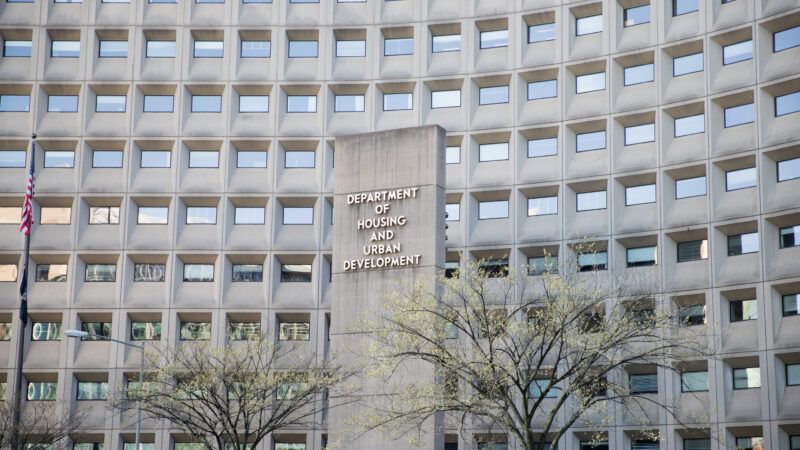New HUD Report Shows Steady Pandemic-Era Increase in Unsheltered Homeless Population
The overall homeless population stayed basically flat from 2020 to 2022. But the number of people sleeping on the streets increased 3.4 percent.

The pandemic didn't produce many more homeless people, but it made a lot of them worse off.
That's the major takeaway from the U.S. Department of Housing and Urban Development's (HUD) latest annual report on the country's homeless population. The data released today shows that homelessness stayed effectively flat over the past two years, but the people who are homeless are more likely to be living on the streets (as opposed to in shelters or transitional housing.)
Overall, 582,462 people in the country lacked permanent housing in 2022. That's a small 0.3 percent increase from the last comprehensive count in 2020 when 580,446 people met the federal government's definition of homeless.
That slight uptick masks a more troubling 3.4 percent increase in unsheltered homelessness reported between 2020 and 2022. This year, an estimated 233,832 people are living on America's streets, in abandoned housing, or in other areas not fit for human habitation.
Worse still, the number of chronically homeless people—defined as someone with a disability or who's been homeless for at least a year within the past three years—increased 16 percent during the past two years to 127,705 individuals.
This latest HUD report is the first to collect comprehensive data on how many people were sleeping on the streets during the pandemic.
Typically, federally funded Continuum of Care (COC) organizations perform yearly point-in-time counts of the unsheltered homeless in late January by sending out teams of volunteers to literally count people sleeping on the streets.
But in 2021, HUD waived the requirement that COCs perform full point-in-counts of the unsheltered homeless people out of social distancing concerns. That left a big hole in the data.
We do know that a lot of shelters slashed capacity in 2020 out of the desire to accommodate social distancing. The shelter system's "decompression" sent thousands of shelter residents out on the street. Other residents voluntarily vacated shelters for fear of catching COVID.
On the flip side, billions in emergency COVID funding was spent converting motel and hotel rooms into "voucher beds" for the homeless. But neither shelter beds lost to social distancing nor hotel-to-shelter conversions were reliably reported to HUD in 2021, clouding the data even more.
Top line figures in today's HUD report show that the overall number of shelter beds (including "voucher beds") increased by some 29,000 from 2020 to 2022. That wasn't enough to stop the overall 7,752-person increase in the unsheltered homeless population.
The news isn't all bad. The number of homeless families declined by 5.5 percent. Veteran homelessness is down 11 percent.
The HUD report and accompanying Biden administration media releases credit the American Rescue Plan's inclusion of emergency rental aid and homelessness funding as well as the extension of the federal eviction moratorium for suppressing the increase in homelessness.
There's likely some truth to that. Moratoriums and rental aid meant fewer people missed rent payments and/or were evicted. That stopped some people from ending up homeless.
Still, evictions remained well below historic averages for months after eviction moratoriums at the federal, state, and/or local levels were lifted or struck down by courts. That's even true of places that were quite slow to disperse federal emergency rental assistance.
The hot rental market of 2022 has done more to push up eviction filings and resulting homelessness, something the HUD report acknowledges. That hot rental market in turn is a product of a lack of housing supply across much of the country. The U.S. has an estimated housing shortage of some 4 million homes.
On a national level, there's also a shortage of shelter beds and housing. HUD reports that there are only 418,642 beds available in shelters and transitional housing, compared to the 580,000 homeless people.
There are only 348,630 sheltered homeless people, suggesting there is significant spare shelter capacity out there. Still, even if all unsheltered homeless were moved inside, there would still be a shortage of beds. New supply is still needed.
Cities like Houston that build a lot of housing and allow a lot of different types of housing to be built have made tremendous progress in housing the homeless.
Cities that make it incredibly hard to build, like Los Angeles, continue to top the charts in terms of the size of their homeless populations. That's in spite of Los Angeles in particular spending a lot of money trying to get people into housing.
And if cities make it hard to build housing generally, you can be sure they make new homeless shelters and supportive housing even more difficult to build. Organizations trying to establish new shelters during the pandemic often were delayed or prevented from doing so by restrictive zoning codes and intransigent local officials
On the heels of the release of the HUD report, the White House announced a new goal of reducing homelessness by 25 percent by 2025.
In setting that goal, it acknowledged the role that limits on housing supply play in driving up homelessness. The White House cited Biden's Housing Supply Action Plan as part of the solution, alongside more federal resources and assistance to local communities.
But the parts of the White House's Supply Action Plan intended to incentivize local zoning reform have been duds thus far. In truth, there's only so much the federal government can do to encourage Los Angeles to be more like Houston.
Seriously reducing homelessness isn't an impossible goal. But the numbers in today's HUD report are a reminder that it's something state and local officials have to do on their own.
Rent Free is a weekly newsletter from Christian Britschgi on urbanism and the fight for less regulation, more housing, more property rights, and more freedom in America's cities.
Show Comments (34)